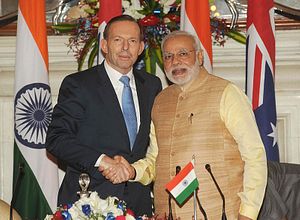Australia has made some significant trade news following its hosting of the G20 summit last weekend. It announced the finalization of a free trade agreement (FTA) with China on Monday, and today Prime Minister Tony Abbott and his Indian counterpart Narendra Modi pledged their intent to forge an additional trade deal. These economic victories will likely be useful for Abbott politically, as he has taken criticism recently for plans to export a major new submarine deal to Japan, which could severely undermine the future of Australia’s own shipbuilding industry.
The China-Australia trade pact is indeed significant. According to an AP report, the FTA would initially lift tariffs on 85 percent of all goods initially, rising to 93 percent after four years. Additionally, “Australia will lift the threshold at which privately-owned Chinese companies can invest in non-sensitive areas without government scrutiny from 248 million Australian dollars ($218 million) to AU$1,078 million.” China would likewise see tariffs on its manufactured goods lifted. The main benefit initially to Australia will be in agriculture, giving it “an advantage over U.S., Canadian and E.U. competitors while negating advantages New Zealand and Chile have enjoyed through their free-trade deals with China,” according to Trade Minister Andrew Robb. Australia-China bilateral trade was $136 billion last year, and while Canberra maintains a trade surplus because of coal and iron ore exports, it’s unknown whether the FTA will shift the trade balance.
While the trade deal with China is reaching its final phases, the proposal with India is still very new. The two leaders announced the plan during an address to the Australian Parliament. Abbott called for a “comprehensive economic partnership agreement with India,” while Modi said “India’s development, demographic and demand provide a unique long-term opportunity for Australia and all in the framework of democracy.” That opportunity is underscored by the fact that bilateral trade in 2013 was roughly one-tenth of Australia and China’s at $13 billion, despite India’s large population and massive need for Australian energy and minerals.
Meanwhile, India’s Adani mining company signed a memorandum of understanding for a $1 billion loan to develop a coal mine in Queensland state, to facilitate an overall project worth $7 billion to also build a connecting rail and port system. The Diplomat spoke to William Hobart, research assistant at the United States Studies Center, University of Sydney, who said this would be a significant deal for both countries because
“Coal already represents our biggest export to India and is catching up to other top markets such as Japan and China… However, there is a long way to go in fully funding the project and those [with] the capital have been cautious to inject more money into the resource sector following abating demand from China.”
According to Hobart, the project also faces additional hurdles due to remaining environmental concerns in Australia and constraints on Indian demand imposed by price fluctuations.
Still, the agreement, which aims to begin building the mine by 2017, could be a significant catalyst for an India-Australia FTA. The effect of the new FTA with China on Australia’s balance of trade and the impact of greater Chinese investment on Australia’s property markets and businesses will also be a factor. If Canberra sees the India FTA agreement as a way to balance against an overdependence on Chinese economic ties, then the deal could see a much easier passage on the Australian side.

































